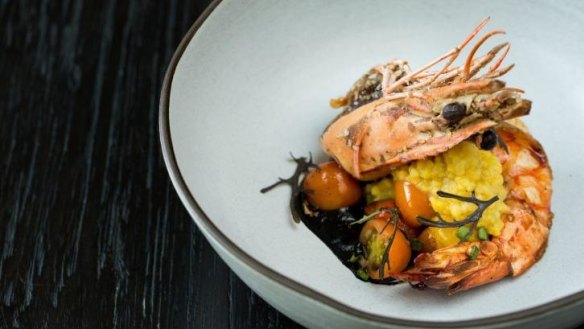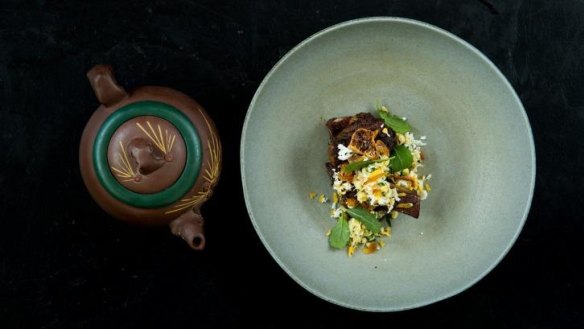Good Food Month: Bali cuisine comes to Melbourne

Bali is known for many things, some good some bad: its beach clubs, infinity pools, massage parlours, raucous party scene and chaotic, lawless traffic. What it was less known for was food, at least until now.
Just a few kilometres north of the chaos of touristy Kuta lies Merah Putih, a restaurant conceived by an Australian chef and a British barman putting Indonesian food on the map.
Merah Putih – which literally translates to "red" and "white", the colours of the Indonesian flag – takes its inspiration from the hawker vendors known as "warungs" where Balinese locals eat.

Melbourne-born head chef Kieran Morland and his British business partner and bar manager, Jasper Manifold, have brought their sophisticated take on Balinese cuisine to Melbourne for the first time as part of The Age Good Food Month, presented by Citi.
After a sell-out pop-up in Perth proved a huge hit in February, Morland and his team have taken over Geoff Lindsay's Elwood restaurant, Dandelion, for two dinners and a lunch this week, after Lindsay opened up a restaurant of his own in Bali in July. The dinners sold out quickly and as of this evening, just one table for lunch remains on November 25.
The 10-course banquet with matching wines will offer Melburnians a taste of Merah Putih's signature dishes – such as babi guling suckling pig, udang slipper lobster and soto, a quail egg served with goat rendang.
Six years ago, Morland and Manifold first dreamed up the idea for a Balinese fine-dining restaurant while working together at Bali beach club institution Ku De Ta.
The baby-faced Morland had done stints in New York at Momofuku and in London before he moved to Bali. It was here he met Manifold, who came to Ku De Ta after reinvigorating Sydney's Beauchamp Hotel.
When foreign tourists came to Ku De Ta, the first question they would ask after their meal was: "Now where can we get some good Indonesian food?", Manifold recalls.
Back then, the best Indonesian meals you could eat in Bali were served in greaseproof paper from the side of the road.
That was how the idea for Merah Putih was born.
While the pair expected the project to take years to come to fruition, they ended up securing backing from the first Indonesian investor they asked.
When it came to the design of the restaurant, there are no infinity pools or ornamental rice paddies.
Instead, Merah Putih features cathedral ceilings made of canvas and spires which funnel rainwater to create a waterfall effect.
"A lot of people think of Bali and think of beautiful villas, restaurants and hotels and all of that is fantastic as long as the skies are blue, but what people don't realise is six months of the year it buckets down with rain," Manifold says.
"We wanted a restaurant that, whether it's dry season, wet season, day or not, it's the same experience for every guest," he said.
While the restaurant was being built, Morland spent three months backpacking around Indonesia eating in local warungs in central Java and working at his girlfriend's family's warung in Surabaya, learning to master authentic Indonesian dishes.
Having never cooked Indonesian food before, Morland faced the daunting task of having to learn to cook Indonesian food better than the locals.
The challenge for Morland was how to make Indonesian food for both Westerners and Indonesian palates.
"Indonesian food is so heavy, really rich curries, super blow-your-head off spicy, really in-your-face flavours," he says. "I didn't want to be too traditional."
With the help of a team of Balinese chefs, Morland's menu riffs off the spicy, sweet, intense flavours found in traditional Indonesian dishes, such as a classic rendang or a nasi goreng or Jimbaran seafood, but uses Western cooking techniques such as grilling instead of frying to make the dishes lighter and more delicate.
"It is a European style of cooking with Balinese flavours. We try to respect the original dishes as much as we can, but cook it in a more refined way to lighten it up," he says.
In a compliment to Morland's cooking, Merah Putih isn't just for tourists. In the two years since it opened, the restaurant now attracts a steady lunchtime rush of Indonesians.
The first thing Indonesians do when they sit down at a meal is taste the sambal. "If the sambal is good, they'll eat it," Manifold says.
While Vietnamese, Thai, Chinese and Japanese are all mainstays on Australian menus, Morland hopes his cooking encourages Australians to develop a love affair with their closest neighbour.
"Hopefully, Indonesian is the next big thing," he laughs.
Merah Putih, at Dandelion, lunch November 25, $99 including wine and champagne.
--